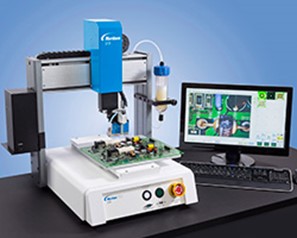Nordson EFD - Dosing equipment
Nordson EFD is the clear market-leading manufacturer of dosing systems and aids for dosing wet products such as glue, grease, solder paste, flux, solvent oil and much more.
Nordson EFD is the clear market-leading manufacturer of dosing systems and aids for dosing wet products such as glue, grease, solder paste, flux, solvent oil and much more.
The products are absolutely of the highest quality on the market and are clearly affordable. A simple way to express it is that an EFD product costs a little more, but you earn much more, because you get a very even and high repeatability in the dosage. This in turn leads to reduced scrap and higher production efficiency. You can simply manufacture more parts in less time, which contributes to competitive advantages.
Video #1: Contact vs. Jet Dispensing
Video #2: 781Mini™ Applications
Video #3: How Pistons Improve Your Dispensing Process - Choosing the right dosing piston improves your dosing results
Video #4: How to Select the Right Piston for Your Fluid - How to choose the right dosing piston for your glue, lubricant or other liquid?
Video #5: How to Set Up a Blue Piston for Thin CAs and Watery Fluids - This is how to install the blue dosing piston for low-viscosity instant glues or other thin-flowing liquids
Video #6: How to Prevent Air Bubbles from Causing Piston Bounce - This prevents air bubbles from causing the dosing piston to bounce
Video #7: How to Fill a Syringe Barrel - This is how you fill syringes in the best way!
In general, the products can be divided into the three categories: tabletop dispensers, cylinder containers & needles and valve systems:
Time-controlled dosing units with different performances for manual and operator-dependent jobs. The operator fills up a suitably sized syringe/cylinder container with the material to be dispensed.
The table dispenser ensures that the right amount is dispensed with very high repeatability.
Is both a good and wide range of high precision dispensing needles. Here you will find, for example, conical needles for a high flow, small stainless needles with a very small inner diameter for dosing micropoints. Also angled needles, flexible needles and needles flattened at the mouth to lay a wide string.
Cylinder containers (syringes) are available in a variety of sizes from 3 ml to 600 ml. Cylinder containers are also available in black material for light-sensitive materials, ESD models that counteract static electricity and UV-blocked for UV-sensitive materials. Most syringes also come with a variety of pistons, depending on the material and viscosity to be dispensed.

The valve program is absolutely of the highest quality and here you can find everything from very small diaphragm valves, excellent for building in when space is limited, to specially designed valves for cyanoacrylate adhesives and solvents.
The range also includes needle valves for dispensing extremely small and repeatable points, spray valves in various designs (for e.g. color marking), selective painting or for spraying oil in micro amounts to slightly larger amounts for e.g. metalworking or on details that need to be oiled during assembly, either manually in or in rope/cell.
For solder pastes and very highly viscous products, there are also screw metering valves that ensure the right amount with high repeatability.
The latest addition is valves that can spit out precise points several centimeters at very high speeds. The advantages are many as you do not have to move the valve and the dispensing needle vertically, but you can simply push out a drop on, for example, a loaded circuit board, this saves a lot of time.
Different industries have different requirements, which is why there are, for example, special valves in stainless material that are FDA-classified and easy to clean and sterilize.
Of course, there are also specially designed control units for each valve that can easily communicate with overall control systems such as a PLC.
